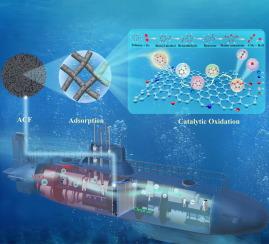Pt/PBO-ACF催化剂对甲苯的整体吸附催化机理:通过调节载体孔隙结构提高催化性能
IF 9
1区 工程技术
Q1 ENGINEERING, CHEMICAL
引用次数: 0
摘要
吸附-催化氧化策略对密闭空间(如军舰)的高效挥发性有机化合物(VOCs)消耗具有重要意义,但也存在挑战。在这项工作中,我们制备了一种以聚对苯基苯并异恶唑(PBO)基活性炭纤维(ACF-KC)负载的铂(Pt)纳米颗粒复合催化剂(Pt/PBO- acf),该催化剂具有催化甲苯氧化的增压性能。ACF-KC具有缺陷工程分层多孔结构(SBET: 2405 m2/g),是一种超高效的甲苯吸附剂(吸附量:555.95 mg/g)和Pt均匀分散的载体(5.66 %)。值得注意的是,0.4Pt/PBO-ACF催化剂在156℃下具有较低的T90,并且通过吸附-催化一体化过程具有长期稳定性和可回收性。漫反射红外傅里叶变换光谱(DRIFTS)和密度泛函理论(DFT)计算进一步揭示了它们背后的双重反应机制(Langmuir-Hinshelwood和Mars-Van Krevelen)。设计的0.4Pt/PBO-ACF复合催化剂,整合了吸附-催化机制,具有在密闭环境下高效转化VOCs的巨大潜力。本文章由计算机程序翻译,如有差异,请以英文原文为准。


Unraveling the integrated adsorption catalytic mechanism of Pt/PBO-ACF catalysts for toluene: Enhancing the catalytic performance by regulating the pore structure of support
Adsorption-catalytic oxidation strategy has great significance but challenge for high-efficient volatile organic compounds (VOCs) consumption in confined spaces (e.g. warships). In this work, we prepared a platinum (Pt) nanoparticles based composite catalyst (Pt/PBO-ACF) supported by the poly-p-phenylene benzobisoxazole (PBO)-based activated carbon fiber (ACF-KC) with supercharged performance in catalytic oxidation of toluene. ACF-KC with a defect-engineered hierarchical porous architecture (SBET: 2405 m2/g) serves as an ultra-efficient adsorbent for toluene (adsorption capacity: 555.95 mg/g) and the support for the uniform dispersion of Pt (5.66 %). Remarkably, the 0.4Pt/PBO-ACF catalyst exhibited a low T90 at 156℃ and long-term stability and recyclability through the integrated adsorption-catalytic process. Diffuse reflectance infrared Fourier transform spectrometry (DRIFTS) and density functional theory (DFT) calculations further revealed a dual-reaction mechanisms (Langmuir-Hinshelwood and Mars-Van Krevelen) behind them. The design of the 0.4Pt/PBO-ACF composite catalyst, integrating the adsorption-catalytic mechanisms, holds remarkable potential for the efficient VOCs conversion in confined environments.
求助全文
通过发布文献求助,成功后即可免费获取论文全文。
去求助
来源期刊

Separation and Purification Technology
工程技术-工程:化工
CiteScore
14.00
自引率
12.80%
发文量
2347
审稿时长
43 days
期刊介绍:
Separation and Purification Technology is a premier journal committed to sharing innovative methods for separation and purification in chemical and environmental engineering, encompassing both homogeneous solutions and heterogeneous mixtures. Our scope includes the separation and/or purification of liquids, vapors, and gases, as well as carbon capture and separation techniques. However, it's important to note that methods solely intended for analytical purposes are not within the scope of the journal. Additionally, disciplines such as soil science, polymer science, and metallurgy fall outside the purview of Separation and Purification Technology. Join us in advancing the field of separation and purification methods for sustainable solutions in chemical and environmental engineering.
 求助内容:
求助内容: 应助结果提醒方式:
应助结果提醒方式:


